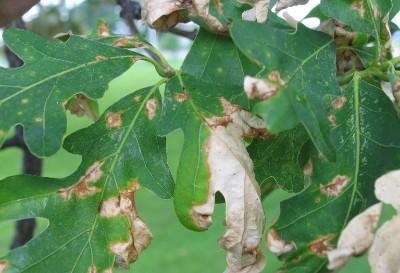Key points
- Anthracnose diseases are characterized by discrete lesions that are usually found along leaf veins.
- In severe cases, these lesions may run together and kill the entire leaf.
- This is an early-season disease and many tree species like sycamore will develop new foliage to replace diseased leaves.
- Young leaves may become distorted as healthy tissue continues to grow around dead areas.
- Under optimum disease conditions (cool, wet, rainy spring weather), the entire tree may be defoliated in the spring or early summer.
- Infection may proceed from the leaf blade down the petiole (leaf stem) into the small twigs at the tips of the tree branches.
- The pathogen may overwinter in the twigs until the infection cycle starts over the next spring.
- Common examples are oak anthracnose, maple anthracnose, and sycamore anthracnose.

Oak anthracnose symptoms. Photo: Joseph OBrien, USDA Forest Service, Bugwood.org

Sycamore anthracnose symptoms. Photo: Jason Sharman, Vitalitree, Bugwood.org
Management
- In most cases, anthracnose leaf diseases on mature trees will not be a major problem threatening the health of the tree.
- The best management practices involve pruning and removal of dead twigs during the winter or dry summer months.
- Mature trees can be thinned for better air circulation throughout the canopy.
- Rake and remove infected fallen leaves in the fall and plant resistant varieties when available.
- It is generally not economical to spray large mature shade trees for anthracnose diseases nor is it effective once disease symptoms are noticeable.
- Young trees or newly planted trees may need fungicide sprays to prevent excessive leaf loss until they become established in the landscape.
